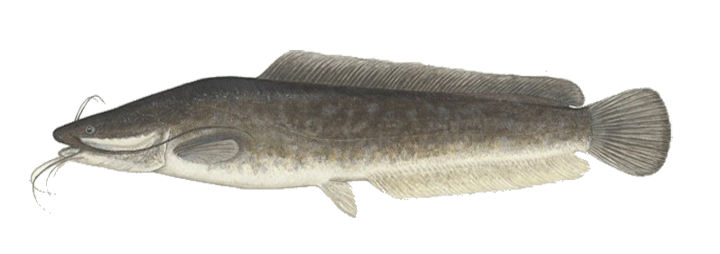Game Fish Identification Reference Guides
Catfish, sharptooth
(Clarias gariepinus)
(Clarias gariepinus)

(Burchell 1822); CLARIIDAE FAMILY; also called North African catfish, kambali, skerptandbaber, baber, mlamba, harlei,
Probably the most widely distributed fish in Africa, the sharptooth catfish is found throughout woodland-savanna zones of the Afro-tropical region from the Nile to as far south as the Orange system and the Umtamvuna. It has been translocated to the eastern Cape widely introduced to other parts of Africa and to Europe and Asia, including the countries of Israel, Jordan, Lebanon, Syria and Turkey.
The body of the sharptoothed catfish is strongly compressed towards the caudal fin. The dorsal fin is entirely of soft rays and extends from behind the head nearly to the base of the caudal fin. The pectoral spine has barbs along the outer edge only. The anal fin entirely of soft rays extends from base of the anus to base of caudal fin, which is rounded. The head large and depressed, heavy boned and completely encased above. Eyes are small and lateral; mouth large, subterminal jaws with broad bands of fine pointed teeth, vomerine band of similar teeth behind the upper jaws on the palate. There are 4 pairs of long filamentous barbles with the maxillaries the longest. First gill arch has numerous close set, slender gill rakers. A large chamber above the gillarches is filled with a multi-branched accessory air-breathing organ. Color varies from almost black to light brown, often marbled in shades of olive green or gray. Underparts of head and abdomen white, sometimes with red flush to extremities of fins especially when spawning.
The sharptooth catfish occurs in almost any habitat but favors flood plains, large sluggish rivers, lakes and dams and can tolerant of extreme environmental conditions. The presence of an accessory breathing organ enables this species to breath air when very active or under conditions of turbidity or desiccation. It is frequently the last inhabitant of drying rivers or lakes where it may form burrows. It can even move overland under damp conditions by “crawling” with its pectoral spines.
While usually a bottom feeder, it occasionally feeds at the surface. It is completely omnivorous, preying or scavenging, on virtually any available food source including fish, birds, frogs, small mammals, reptiles, snails, crabs, shrimps, insects, and plant matter such as seeds and fruit, and is even capable of straining fine plankton if necessary. It has been known to hunt in packs, herding and trapping smaller fishes.
Sharptooth catfish are a dominant ecological presence wherever they occur, so those introductions may threaten native fauna. It is an important angling and food fish species, well known for its hardiness and good angling qualities
Probably the most widely distributed fish in Africa, the sharptooth catfish is found throughout woodland-savanna zones of the Afro-tropical region from the Nile to as far south as the Orange system and the Umtamvuna. It has been translocated to the eastern Cape widely introduced to other parts of Africa and to Europe and Asia, including the countries of Israel, Jordan, Lebanon, Syria and Turkey.
The body of the sharptoothed catfish is strongly compressed towards the caudal fin. The dorsal fin is entirely of soft rays and extends from behind the head nearly to the base of the caudal fin. The pectoral spine has barbs along the outer edge only. The anal fin entirely of soft rays extends from base of the anus to base of caudal fin, which is rounded. The head large and depressed, heavy boned and completely encased above. Eyes are small and lateral; mouth large, subterminal jaws with broad bands of fine pointed teeth, vomerine band of similar teeth behind the upper jaws on the palate. There are 4 pairs of long filamentous barbles with the maxillaries the longest. First gill arch has numerous close set, slender gill rakers. A large chamber above the gillarches is filled with a multi-branched accessory air-breathing organ. Color varies from almost black to light brown, often marbled in shades of olive green or gray. Underparts of head and abdomen white, sometimes with red flush to extremities of fins especially when spawning.
The sharptooth catfish occurs in almost any habitat but favors flood plains, large sluggish rivers, lakes and dams and can tolerant of extreme environmental conditions. The presence of an accessory breathing organ enables this species to breath air when very active or under conditions of turbidity or desiccation. It is frequently the last inhabitant of drying rivers or lakes where it may form burrows. It can even move overland under damp conditions by “crawling” with its pectoral spines.
While usually a bottom feeder, it occasionally feeds at the surface. It is completely omnivorous, preying or scavenging, on virtually any available food source including fish, birds, frogs, small mammals, reptiles, snails, crabs, shrimps, insects, and plant matter such as seeds and fruit, and is even capable of straining fine plankton if necessary. It has been known to hunt in packs, herding and trapping smaller fishes.
Sharptooth catfish are a dominant ecological presence wherever they occur, so those introductions may threaten native fauna. It is an important angling and food fish species, well known for its hardiness and good angling qualities












